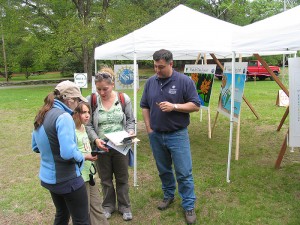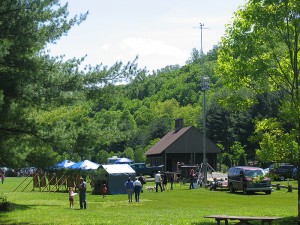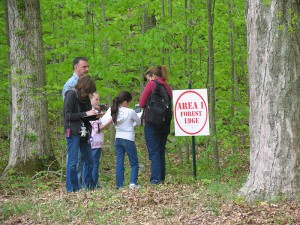
What could be better on a warm summer’s day than an outdoor activity that combines playing in the woods with conducting a low key science experiment that’s fun for the whole family?
UConn’s Mark Rudnicki, associate professor of forest ecology in the College of Agriculture and Natural Resources, has developed a program that provides just that scenario.
Rudnicki’s work on how wind flows through forest canopies is funded with a grant from the National Science Foundation. As part of his grant, which involves both atmospheric studies and forest ecology, Rudnicki accepted the challenge of developing outreach activities that would appeal to a younger audience. In this case, it’s children who might not believe that the study of science can be fun, nor understand its practical application outside traditional classroom settings.
Rudnicki says, “Broader impacts of NSF research projects aren’t typically aimed at grade school kids, and it can be hard for scientists to get down to that age level, but the NSF really likes the fact that not only are we doing basic research in forest meteorology, but we also have this grassroots effort to get kids interested in science.”
His program also supports the federal government’s “No Child Left Inside” initiative which is designed to encourage environmental education for children from kindergarten age through high school.
With the cooperation of Connecticut’s Department of Environmental Protection and its counterpart in other New England states, Rudnicki developed an activity that is both simple and engaging. Because he actually piggybacks on existing state-sponsored programs, he and his students have a ready-made audience when they show up at state parks with their gear.

Most impressive, and sure to get the attention of youngsters, is a portable meteorological tower that rises about 60 feet above the forest floor. Mounted on top is equipment that can measure wind flow at the level of the forest canopy.
Families step up on site for a chance to take part in a forest meteorology experiment that involves measuring the temperature and the wind speed (and in some cases the light) at various locations in and near the forest. Each family team is loaned the appropriate equipment. Anemometer. Light meter. Clip board with experiment sheets where participants write down their hypotheses and can draw conclusions.
Rudnicki says, “They have a lot of fun, usually a little more than the parents bargain for, but the kids love it. They love the gadgets and I think they get a lot out of it. The experiment seems to be just right in terms of difficulty, and they can wrap it up in about 15 minutes.”
The first order of business is developing a hypothesis, and that’s where the parents usually help out the most. “The hypothesis helps the kids come up with an idea,” Rudnicki says. “For instance, they hypothesize that the wind is going to be faster or slower on the edge of the forest than it will be deeper inside the woods, or out in the open. They actually measure the wind and collect the data, and they learn that the scientific method can be used by anyone.”

The rest of the time is spent learning about forest ecology from the posters and handouts Rudnicki and his students bring along, turning in data, and seeing first-hand how variable the weather can be, even within very small geographic areas.
According to Rudnicki, one of the most positive things about the program is that, “By going to this free event, we try to reach all kids, not just the ones who go to science camp or are in science magnet schools. What we are doing combines families and science and getting to know the environment … and when families work together on simple projects like this, maybe they’ll realize that more complicated things such as global climate change are real. And, maybe that will inspire them to learn more and get involved with what’s happening to their planet.”
The NSF likes the program so much that it has added some supplemental funding so that Rudnicki and his students can go farther afield in New England. So far this year, they’ve held programs in Rhode Island, Vermont, and New Hampshire, and Maine is on the schedule at the end of June.


